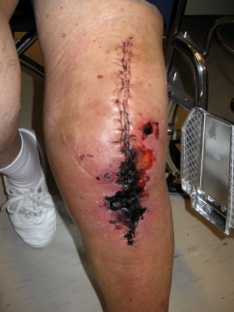Background
Issues
Host
Wound
Operating room environment
Antibiotics
Operative technique
Post operative
Host
Immunocompromised
RA (0.9 v 2.2%)
Psoriasis
DM (6%)
Poor nutrition
Obesity
UTI
Prednisone
Previous operation
Previous infection
Age
Host
Wound
Operating room environment
Antibiotics
Operative technique
Post operative
Immunocompromised
RA (0.9 v 2.2%)
Psoriasis
DM (6%)
Poor nutrition
Obesity
UTI
Prednisone
Previous operation
Previous infection
Age
 Incidence
Incidence
10 -15%
Include
- marginal necrosis
- wound slough
- sinus tract formation
- dehiscence
- haematoma
- oozing knee wound
Anterior knee has no muscles to supply vessels directly
Identify high risk groups
- immunocompromised
- diabetes
- RA
- malnutrition
Urine screen
- check for and treat UTi
Groin, nose, axilla swabs
- for MRSA
- if positive, treat
- need 3 consecutive free swabs
3 x chlorhexidine preoperative showers in 8 hours
Admit day of surgery
- check skin for lesions
Pathological bone formation in soft tissues
In elbow
- 3% of trauma
- 89% if head injury + trauma
Completely different
1. Myosisitis Ossificans Circumscripta
- post traumatic
- more common
- recognised as a consequence of neurological injury

Extraskeletal bone formation in periarticular tissues
- HA crystals within osteoid matrix
Different to calcification
- osteoid matrix laid down
1. Myositis Ossificans
- post traumatic
Top 6 conditions associated with DVT
- stroke
- THR
- multi trauma
- TKR
- hip fracture
- spinal cord injury
Not one of the 12 doctors was an orthopaedic surgeon
Heparin / LMWH / fondaparinux
- confirmed effectiveness
Acute disease
- characterised by generalized rigidity & convulsions
- caused by exotoxins/neurotoxins produced in Clostridia Tetani infections
Annual world mortality is 1 million
West 15-100/year
Clostridium Tetani
- anaerobic
- spore-bearing Gram positive Bacillus